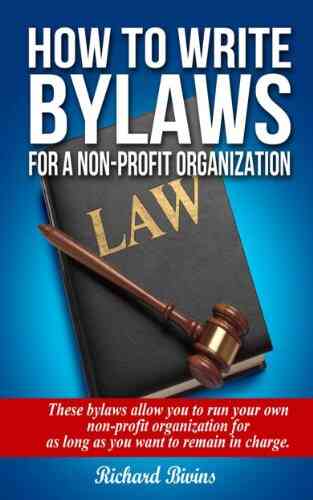Ultimate Guide: Learn How To Write Bylaws for a Nonprofit Organization

Are you passionate about making a positive change in your community? Starting a nonprofit organization can be a fulfilling way to address social issues and make a lasting impact. However, to ensure your nonprofit operates smoothly and transparently, it is essential to establish a solid foundation through well-crafted bylaws.
Bylaws are the guiding principles that govern the operations and decision-making processes within a nonprofit organization. They provide a framework for how the organization will be managed, outline the roles and responsibilities of board members and officers, and establish the procedures for important matters such as annual meetings, voting, and amendments.
In this comprehensive guide, we will walk you through the step-by-step process of writing bylaws for your nonprofit organization. By the end, you will have a clear understanding of what needs to be included in your bylaws and how to ensure they comply with legal requirements.
4 out of 5
| Language | : | English |
| File size | : | 164 KB |
| Text-to-Speech | : | Enabled |
| Enhanced typesetting | : | Enabled |
| Word Wise | : | Enabled |
| Print length | : | 20 pages |
| Lending | : | Enabled |
| Screen Reader | : | Supported |
1. Understand the Legal Requirements
Before you start writing your bylaws, it is crucial to familiarize yourself with the legal requirements imposed by your local jurisdiction. Every state or country has its own set of regulations and laws that govern nonprofit organizations, and your bylaws must align with these requirements.
Research the laws and regulations specific to your region regarding nonprofit organizations. Some common areas to consider include the minimum number of board members, the process for electing or removing board members, financial reporting obligations, and any restrictions on activities or advocacy efforts.
2. Define Your Nonprofit's Purpose and Mission
Every nonprofit organization has a purpose and mission that drives its work. Take the time to clearly articulate your organization's purpose and mission statement, as it will act as a compass for your future activities and decisions.
Your purpose statement should explain the overarching goal your organization aims to achieve, while your mission statement provides a more detailed description of the specific actions you will take to fulfill your purpose. Make sure these statements accurately reflect the values and objectives of your nonprofit.
3. Determine Organizational Structure and Governance
Next, you need to define the organizational structure and governance of your nonprofit. This includes identifying the different levels of leadership, such as board members, officers, and committees, and specifying their roles and responsibilities.
Consider how many board members you will have and what qualifications they should possess. Determine the duration of their terms and the process for electing or appointing new members. Additionally, outline the responsibilities of officers, such as the President, Treasurer, and Secretary, as well as any committees that may be required.
4. Establish Meeting Procedures
To ensure transparency and accountability within your nonprofit, it is vital to establish clear procedures for meetings. Outline how often board meetings will be held, where they will take place, and how much notice needs to be given.
Specify the required quorum for making decisions and voting on important matters. Additionally, define the process for remote participation, in case some board members are unable to attend in person.
5. Address Financial Management and Reporting
Financial management is a critical aspect of running a nonprofit organization. Your bylaws should address how the organization's finances will be managed, including setting guidelines for budgeting, fundraising, and financial reporting.
Outline the responsibilities of the Treasurer and establish the process for approving the annual budget. Consider including provisions for conducting regular audits or reviews of financial records to ensure transparency and accountability.
6. Include Conflict of Interest Policies
It is crucial to address any potential conflicts of interest within your nonprofit organization. Develop clear policies that require board members and officers to disclose any conflicts and refrain from participating in related decision-making processes.
By including conflict of interest provisions in your bylaws, you demonstrate your commitment to integrity, transparency, and ethical conduct.
7. Anticipate Amendments and Dissolution
As your nonprofit organization evolves, there may be a need to amend your bylaws to accommodate changes in operations or legal requirements. Anticipate this by including procedures for making amendments, such as the majority vote required or the need for advanced notice.
In addition, include provisions for the dissolution of your nonprofit in case it becomes necessary in the future. Specifying how assets will be distributed and how any remaining commitments will be resolved ensures a smooth process if dissolution ever occurs.
8. Seek Legal Review
Once you have drafted your bylaws, it is highly recommended to seek legal review. Consulting with an attorney or a nonprofit expert can help ensure that your bylaws comply with local regulations and cover all the necessary elements to protect your organization's interests.
Legal professionals can provide valuable guidance and help you identify any potential issues or areas for improvement in your bylaws before they are finalized.
Writing bylaws for a nonprofit organization is a crucial step in establishing a strong foundation for your mission-driven work. By taking the time to carefully define your organization's purpose, roles, procedures, and policies, you set the stage for long-term success.
Remember, your bylaws should be tailored specifically to your nonprofit and its unique needs. Regularly review and update them as your organization grows and changes. By doing so, you ensure that your nonprofit remains transparent, accountable, and capable of making a meaningful impact for years to come.
So, roll up your sleeves, get started, and empower your nonprofit organization with clear and comprehensive bylaws that guarantee its success!
4 out of 5
| Language | : | English |
| File size | : | 164 KB |
| Text-to-Speech | : | Enabled |
| Enhanced typesetting | : | Enabled |
| Word Wise | : | Enabled |
| Print length | : | 20 pages |
| Lending | : | Enabled |
| Screen Reader | : | Supported |
This guide was designed to help create a set of bylaws for a nonprofit organization in a way that allows the founder to remain in control of the nonprofit for as long as the founder chooses. It is not uncommon for a nonprofit’s board of directors to alter the vision of the founder and take the organization on a divergent path. Bylaws, in most jurisdictions, do not need to be filed along with the articles of incorporation. They are purposely drafted to become the internal playbook for the organization and describe with detail the function of every member, committee, and every office. This guide is short and to the point and will allow the founder to solidify a vision for the organization.
Do you want to contribute by writing guest posts on this blog?
Please contact us and send us a resume of previous articles that you have written.




















Light bulbAdvertise smarter! Our strategic ad space ensures maximum exposure. Reserve your spot today!
 Jacques BellFollow ·15.3k
Jacques BellFollow ·15.3k Wayne CarterFollow ·5.2k
Wayne CarterFollow ·5.2k Roy BellFollow ·14.9k
Roy BellFollow ·14.9k Asher BellFollow ·8.8k
Asher BellFollow ·8.8k Scott ParkerFollow ·2.8k
Scott ParkerFollow ·2.8k Guy PowellFollow ·2.2k
Guy PowellFollow ·2.2k Bryce FosterFollow ·10.6k
Bryce FosterFollow ·10.6k Richard WrightFollow ·5.1k
Richard WrightFollow ·5.1k

 Dwayne Mitchell
Dwayne MitchellSaving The Maldives: The Floating Island
The Maldives, known for...

 Ethan Mitchell
Ethan MitchellManaging The Production Hour: Mastering Efficiency and...
As businesses strive to meet growing demands...

 Virginia Woolf
Virginia WoolfThe Food Lab: Better Home Cooking Through Science
Have you ever wondered why some...

 Jeff Foster
Jeff FosterThe Darling Songbirds: The Songbirds of Darling Bay
When it comes to enchanting melodies and...

 Eli Blair
Eli BlairDeath And New Life In Pandemic
The COVID-19 pandemic has brought about...

 Dave Simmons
Dave SimmonsThe Unstoppable Nathan Run: A Thrilling Journey Into John...
When it comes to gripping thriller novels,...

 Amir Simmons
Amir SimmonsDistant Horizon Backyard Starship: Exploring the Cosmos...
The mysteries of the universe...

 Simon Mitchell
Simon MitchellUnveiling the Secrets: The DNA of a Disciple - A...
Do you ever wonder what it takes to become a...

 Samuel Taylor Coleridge
Samuel Taylor ColeridgeThe Epic Tale of Snake River Slaughter: Matt Jensen, The...
The Snake River, winding through the...

 Ray Blair
Ray BlairThe Ultimate Covid Alphabet For Teachers: The Key to a...
With the Covid-19 pandemic still ongoing,...

 Gage Hayes
Gage HayesFor The Sake Of Family: Why Prioritizing Our Loved Ones...
Family is the backbone of...
4 out of 5
| Language | : | English |
| File size | : | 164 KB |
| Text-to-Speech | : | Enabled |
| Enhanced typesetting | : | Enabled |
| Word Wise | : | Enabled |
| Print length | : | 20 pages |
| Lending | : | Enabled |
| Screen Reader | : | Supported |






















